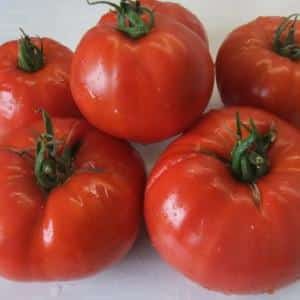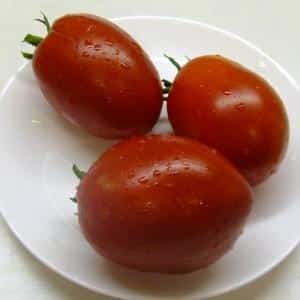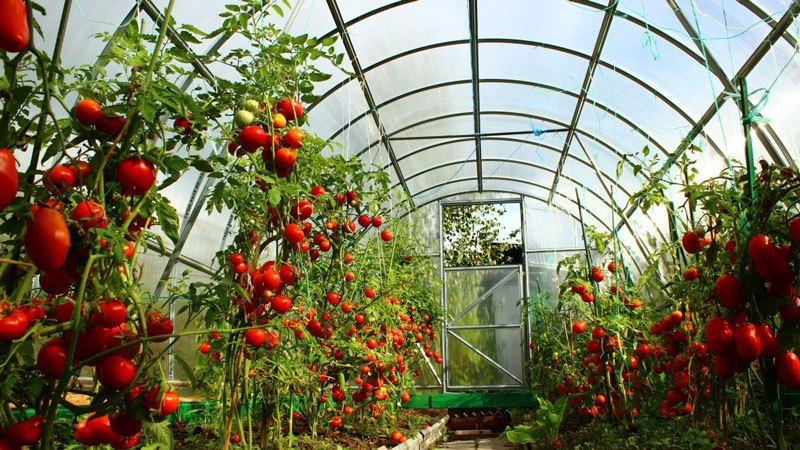Why are Minusinsk tomatoes valuable?
The “homeland” of Minusinsk tomatoes is the city of Minusinsk, Krasnoyarsk Territory, where they were bred by one of the leading gardeners. “Minusinsk Tomato Day” is even celebrated here. This group of varieties is famous not only for its resistance to cold, impressive size, but also for the incredible taste of the fruit.
Minusinsk tomatoes are consistently popular among gardeners. Many note their high yield, as well as the ability to grow both in open ground and in greenhouses.
In the article we will talk in detail about the features of Minusinsk tomatoes, varieties, and also give advice on growing and care.
Characteristics and description of the variety
Minusinsk tomatoes are classified as mid-season indeterminate (tall) varieties. The bush can reach up to 2.5 meters in height and requires garter. Most often, the bush develops one or two stems. The leaves of the plant are medium in size and dark green in color.
Tomato fruits reach up to 1 kg and have a rich crimson color. The photo shows that the tomato has smooth skin and small seed chambers. The pulp of the fruit is juicy, not watery. It is also known that Minusinsk tomatoes are famous for their excellent sweet taste.
Apple variety
Apple tomato is a mid-season, sleepy variety. The bush is tall and requires timely garter. Compared to other varieties, apple is relatively small (up to 500 g). Tomato fruits are red, flat-round in shape. The taste is harmonious, balanced, pleasant.Gardeners who grow the variety report good yields.
Minusinsk glasses
 These glass-shaped tomatoes are not suitable for growing in the middle and northern regions, so they are recommended to be planted in greenhouses. Available in pink, bright red or orange-pink color. The length of the stem reaches 2.5 m, and the fruits themselves are distinguished by their small size - up to 300 g.
These glass-shaped tomatoes are not suitable for growing in the middle and northern regions, so they are recommended to be planted in greenhouses. Available in pink, bright red or orange-pink color. The length of the stem reaches 2.5 m, and the fruits themselves are distinguished by their small size - up to 300 g.
The fruit has a dense peel, which makes it not susceptible to cracking. Due to the increased sugar content, tomato is most often consumed fresh. However, this variety is also suitable for preservation.
In terms of external and taste characteristics, “Glass” is often confused with the “Minusinsk bulls” variety, however, the latter differs in the shape of the fruit.
Read also:
How to grow a Black Elephant tomato.
Advantages and disadvantages of the Raspberry Elephant variety.
Top 25 sweetest varieties of tomatoes and tips on choosing them for every gardener.
Minusinsk bulls
This is a tall plant that sometimes reaches the top of the greenhouse, requiring it to be pinched back. Each cluster contains 5-6 fruits. They have an oval-cylindrical shape and a slightly elongated “nose”.
The fruits have a rich pink color. The pulp is dense, fleshy, with excellent taste. The weight of tomatoes is 250-400 g. Excellent for salads.
Burlak Early Ripe
Minusinsk barge hauler is considered the only early ripening variety. The leaves of the plant are shaped like potato leaves. The stem reaches a length of 1.8 m. The fruits of the variety are flat. Their weight reaches 500 g. The pulp is clearly grainy, juicy and very sweet.
Minusinsk tomatoes
The Minusinsk tomato is one of the “progenitors” of the variety varieties.The characteristics of this tomato are considered reference for the development of derivative varieties. The fruits reach up to 1 kg. When ripe, it has a rich raspberry hue and a bright taste. Unripe fruits are slightly sour, but are also used for cooking.
Balls Minusinsk
The fruits of the Minusinsk balls are dense, not very juicy, but sweet. They are intolerant of high soil moisture. The weight of the fruit reaches only 200 g, therefore, compared to other varieties, they look like real dwarfs. The yield of a bush with such a fruit weight is no more than 3.5 kg.
Giant
The weight of the fruits of the Minusinsk giant varies from 300 g to 1.5 kg. It depends on the growing conditions. To obtain large fruits, all the stepsons are removed from the main stem. To get tomatoes weighing up to 600 g, it is recommended to leave the lower stepsons.
These fruits are distinguished by their bright red color and sugary taste.
Harvest
The variety is considered the most fertile. The yield of the bush reaches up to 6 kg. Individual fruits reach a weight of up to 400 g when grown on a single-stem bush. The bush reaches a height of up to 1.8 m. The leaves are of the usual type. It is recommended to grow this variety in the middle zone in greenhouses. The fruits have a round shape, a rich red color and a magnificent, juicy taste.
Minusinsk flat hearts
The tomato gets its name from its slightly flattened shape. The average fruit weight is between 250-350 g. They are heart-shaped and have a bright crimson hue. The height of the bush reaches 2 m. Requires gartering and pinching. The leaves are long. Up to 3-5 fruits ripen on a cluster. The pulp of tomatoes is low-seeded and fleshy. Well suited for making sauces and juices.
Advantages and disadvantages
Minusinsk tomatoes have many advantages over other varieties:
- high productivity;
- good taste of fruits and their large size;
- the ability to grow the variety both in greenhouses and in open ground;
- fruit resistance to cracking.
Flaws:
- instability to temperature changes;
- requirement for regular watering and weeding;
- complex agricultural technology of plants (the bushes require tying up after planting in a permanent place growth).
Productivity
This tomato variety is harvested from mid-July to the end of August. Some plants may bear fruit before the first frost. If all requirements for agricultural technology are met, vegetable growers are able to harvest up to 4 kg of fruit from one plant. If the plant did not receive the necessary fertilizers and sufficient glaze, the yield can be reduced to 2 kg of tomatoes per bush.
Growing and care
Seeds of Minusinsk tomatoes are not recommended to be sown directly into the ground. They need to be grown by seedlings to achieve good germination.
It is recommended to prepare seedlings 60 days before transplanting plants to a permanent place of growth. To grow seedlings, special deep boxes are used. It is better to take universal ready-made soil. The soil temperature should not be below +22 degrees, otherwise the seedlings may die.
In the open ground
Seeds for seedlings are sown in early or mid-March.
To grow young viable plants you need:
- Properly prepare seeds for planting. To do this, they need to be placed in a cloth moistened with warm, clean water for a day.
- Prepare the soil for seedlings. If you use a ready-made mixture from the store, just bake it in the oven.It is important that its temperature is not lower than +22 degrees at the time of sowing the seed. If you use soil collected from your own local area, pre-treat it with a weak solution of potassium permanganate for the purpose of disinfection.
- Seeds are sown in seedling pots at a distance of 2 cm from each other and buried 1 cm in the ground. After this, the seedlings are watered and covered with film or glass.
- When the first shoots appear in the pots, the film is removed. After this, the seedlings are watered once a week. Also during this period it is necessary to create temperature fluctuations for tomatoes. Move the boxes from one place to another so that the temperature readings change. Do this daily.
- As soon as the plants have 2 true leaves, the seedlings need to be pricked. Viable, strong plants are planted in separate pots. Two weeks after this, the plants are fed with a nitrophoska solution.
- Before transplanting tomatoes to a permanent growing location, the crop must be “hardened off”. To begin with, take the flowerpots with young tomatoes outside for an hour, gradually increasing the time spent in the air.
- As the bush grows, it needs to be pinched. The top must be trimmed so that it produces shoots. The side branches are gradually removed so that they do not take away the vitality of the plant.
After the plant has at least 8 leaves and one true inflorescence, it is transplanted to a permanent place of growth. Small holes up to 12 cm deep are prepared for plants. They are arranged in a checkerboard pattern so that there are no more than 3 plants per 1 square meter.The tomatoes are transplanted into holes together with a lump of earth, dug in, leaving a small depression around the plant, and watered again.
After planting the plants in the ground, they will need care:
- plucking a bush;
- mulching the soil;
- watering at least once a week;
- fertilizing with mineral fertilizers 2 times during the flowering period and 2 times during the growing season.
In greenhouses
In greenhouse conditions, tomato bushes with 2 stems are formed. After they reach a height of 1.45 m, the plants are pinched to stop growth. Mandatory elements of caring for bushes here remain regular watering of tomatoes in the greenhouse, fertilizing, tying to a trellis. Watering both in greenhouse conditions and in open ground is done strictly at the root. If water gets on the leaves, it may cause burns.
Also, Minusinsk tomatoes grown in a greenhouse need to be provided with the correct level of humidity. It should not exceed 70%, especially during the flowering period of plants. For this purpose, be sure to ventilate the greenhouse, especially after watering.

Reviews
Minusinsk tomatoes are characterized by positive reviews. Most gardeners note the unique taste of tomatoes, high yield and large weight of fruits. Many people share delicious recipes for sauces and juice from these tomatoes.
However, there are also reviews in which gardeners complain that the plant stems are weak and require garter. But this does not negate the excellent taste and yield qualities of this variety.
Conclusion
The Minusinsk tomato is very popular among gardeners precisely due to its high yield, good taste of the fruit and its large size. You can grow such a crop on your own plot and achieve a good harvest from it in the very first year of work.To do this, it is enough to carefully study the recommendations on agricultural technology for this crop, select high-quality seed material and then follow all the recommendations of gardeners.
The basic requirements are as follows: plant seeds for seedlings, transplant young plants in time to a place of permanent growth and care for them until the end of the harvest.